Variation of Runoff and Runoff Components of the Lhasa River Basin in the Qinghai-Tibet Plateau under Climate Change
Abstract
:1. Introduction
2. Materials and Methods
2.1. Study Areas
2.2. Data Source
2.3. Methodology
2.3.1. Hydrograph Partitioning Curves
2.3.2. Spatial Processes in Hydrology Model
2.3.3. Calibration of the SPHY Model
2.3.4. Statistical Downscaling Model
3. Results
3.1. Results of the HPC Division Method
3.2. Performance of the SPHY Model
3.3. Assessments of Runoff Components
3.4. Results of the SDSM
3.5. Runoff Response under Future Climate Scenarios
4. Discussion
5. Conclusions
Author Contributions
Funding
Institutional Review Board Statement
Informed Consent Statement
Data Availability Statement
Acknowledgments
Conflicts of Interest
References
- Qiu, L.; Peng, D.; Hu, L.; Zhang, M. Simulation of snowmelt runoff in the LHASA river basin by MODIS and SRM. J. Beijing Normal Univ. Nat. Sci. 2013, 49, 152–156. [Google Scholar]
- Hebert, R.; Lovejoy, S. Regional Climate Sensitivity- and Historical-Based Projections to 2100. Geophys. Res. Lett. 2018, 45, 4248–4254. [Google Scholar] [CrossRef]
- Tian, F.; Xu, R.; Nan, Y.; Li, K.; He, Z. Quantification of runoff components in the Yarlung Tsangpo River using a distributed hydrological model. Adv. Water Sci. 2020, 31, 324–336. [Google Scholar]
- Gao, Z.; Wang, X.; Yin, G. Isotopic effect of runoff in the Yarlung Zangbo River. Chin. J. Geochem. 2012, 31, 309–314. [Google Scholar] [CrossRef]
- Liu, J.T.; Gao, Z.J.; Wang, M.; Li, Y.Z.; Yu, C.; Shi, M.J.; Zhang, H.Y.; Ma, Y.Y. Stable isotope characteristics of different water bodies in the Lhasa River Basin. Environ. Earth Sci. 2019, 78, 11. [Google Scholar] [CrossRef]
- Yu, T.-T.; Gan, Y.-Q.; Zhou, A.-G.; Liu, C.-F.; Liu, Y.-D.; Li, X.-Q.; Cai, H.-S. Characteristics of Oxygen and Hydrogen Isotope Distribution of Surface Runoff in the Lhasa River Basin. Earth Sci. 2010, 35, 873–878. [Google Scholar] [CrossRef]
- Beven, K.; Freer, J. Equifinality, data assimilation, and uncertainty estimation in mechanistic modelling of complex environmental systems using the GLUE methodology. J. Hydrol. 2001, 249, 11–29. [Google Scholar] [CrossRef]
- Prasch, M.; Weber, M.; Mauser, W. Distributed modelling of snow- and ice-melt in the Lhasa River basin from 1971 to 2080. In Proceedings of the 25th General Assembly of the International Union of Geodesy and Geophysics, Melbourne, Australia, 28 June–7 July 2011. [Google Scholar]
- Qiu, L.H.; You, J.J.; Qiao, F.; Peng, D.Z. Simulation of snowmelt runoff in ungauged basins based on MODIS: A case study in the Lhasa River basin. Stoch. Environ. Res. Risk Assess. 2014, 28, 1577–1585. [Google Scholar] [CrossRef]
- Zhang, G.Q.; Xie, H.J.; Yao, T.D.; Li, H.Y.; Duan, S.Q. Quantitative water resources assessment of Qinghai Lake basin using Snowmelt Runoff Model (SRM). J. Hydrol. 2014, 519, 976–987. [Google Scholar] [CrossRef]
- Choi, J.R.; Chung, I.M.; Jeung, S.J.; Choo, K.S.; Oh, C.H.; Kim, B.S. Development and Verification of the Available Number of Water Intake Days in Ungauged Local Water Source Using the SWAT Model and Flow Recession Curves. Water 2021, 13, 1511. [Google Scholar] [CrossRef]
- Kumar, M.; Denis, D.M.; Kundu, A.; Joshi, N.; Suryavanshi, S. Understanding land use/land cover and climate change impacts on hydrological components of Usri watershed, India. Appl. Water Sci. 2022, 12, 39. [Google Scholar] [CrossRef]
- Alipour, M.; Hosseini, M. Simulation of surface runoff in Karaj dam basin, Iran. Appl. Water Sci. 2018, 8, 147. [Google Scholar] [CrossRef]
- Pandey, B.K.; Gosain, A.K.; Paul, G.; Khare, D. Climate change impact assessment on hydrology of a small watershed using semi-distributed model. Appl. Water Sci. 2017, 7, 2029–2041. [Google Scholar] [CrossRef] [Green Version]
- Terink, W.; Lutz, A.F.; Simons, G.W.H.; Immerzeel, W.W.; Droogers, P. SPHY v2.0: Spatial Processes in HY drology. Geosci. Model Dev. 2015, 8, 2009–2034. [Google Scholar] [CrossRef] [Green Version]
- Lutz, A.F.; Immerzeel, W.W.; Shrestha, A.B.; Bierkens, M.F.P. Consistent increase in High Asia’s runoff due to increasing glacier melt and precipitation. Nat. Clim. Change 2014, 4, 587–592. [Google Scholar] [CrossRef] [Green Version]
- Wu, J.K.; Li, H.Y.; Zhou, J.X.; Tai, S.Y.; Wang, X.L. Variation of Runoff and Runoff Components of the Upper Shule River in the Northeastern Qinghai-Tibet Plateau under Climate Change. Water 2021, 13, 3357. [Google Scholar] [CrossRef]
- Eekhout, J.P.C.; Millares-Valenzuela, A.; Martinez-Salvador, A.; Garcia-Lorenzo, R.; Perez-Cutillas, P.; Conesa-Garcia, C.; de Vente, J. A process-based soil erosion model ensemble to assess model uncertainty in climate-change impact assessments. Land Degrad. Dev. 2021, 32, 2409–2422. [Google Scholar] [CrossRef]
- Singh, V.; Jain, S.K.; Shukla, S. Glacier change and glacier runoff variation in the Himalayan Baspa river basin. J. Hydrol. 2021, 593, 17. [Google Scholar] [CrossRef]
- Latif, Y.; Ma, Y.M.; Ma, W.Q.; Muhammad, S.; Adnan, M.; Yaseen, M.; Fealy, R. Differentiating Snow and Glacier Melt Contribution to Runoff in the Gilgit River Basin via Degree-Day Modelling Approach. Atmosphere 2020, 11, 1023. [Google Scholar] [CrossRef]
- Immerzeel, W.W.; van Beek, L.P.H.; Bierkens, M.F.P. Climate Change Will Affect the Asian Water Towers. Science 2010, 328, 1382–1385. [Google Scholar] [CrossRef]
- Qiu, J. The third pole. Nature 2008, 454, 393–396. [Google Scholar] [CrossRef] [PubMed] [Green Version]
- Bolch, T.; Kulkarni, A.; Kaab, A.; Huggel, C.; Paul, F.; Cogley, J.G.; Frey, H.; Kargel, J.S.; Fujita, K.; Scheel, M.; et al. The State and Fate of Himalayan Glaciers. Science 2012, 336, 310–314. [Google Scholar] [CrossRef] [PubMed]
- Xu, Z.X.; Gong, T.L.; Li, J.Y. Decadal trend of climate in the Tibetan Plateau—Regional temperature and precipitation. Hydrol. Process. 2008, 22, 3056–3065. [Google Scholar] [CrossRef]
- Xie, H.; Zhu, X. Reference evapotranspiration trends and their sensitivity to climatic change on the Tibetan Plateau (1970–2009). Hydrol. Process. 2013, 27, 3685–3693. [Google Scholar] [CrossRef]
- Barnett, T.P.; Adam, J.C.; Lettenmaier, D.P. Potential impacts of a warming climate on water availability in snow-dominated regions. Nature 2005, 438, 303–309. [Google Scholar] [CrossRef]
- Qin, D.; Xiao, C. Global climate change and cryospheric evolution in China. Eur. Phys. J. Conf. 2008, 1, 19–28. [Google Scholar] [CrossRef] [Green Version]
- Lu, H.T.; Yan, Y.; Zhu, J.Y.; Jin, T.T.; Liu, G.H.; Wu, G.; Stringer, L.C.; Dallimer, M. Spatiotemporal Water Yield Variations and Influencing Factors in the Lhasa River Basin, Tibetan Plateau. Water 2020, 12, 1498. [Google Scholar] [CrossRef]
- Zhang, Y.G.; Xu, C.Y.; Hao, Z.C.; Zhang, L.L.; Ju, Q.; Lai, X.D. Variation of Melt Water and Rainfall Runoff and Their Impacts on Streamflow Changes during Recent Decades in Two Tibetan Plateau Basins. Water 2020, 12, 3112. [Google Scholar] [CrossRef]
- Lin, X.D.; Zhang, Y.L.; Yao, Z.J.; Gong, T.L.; Wang, H.; Chu, D.; Liu, L.S.; Zhang, F. The trend on runoff variations in the Lhasa River Basin. J. Geogr. Sci. 2008, 18, 95–106. [Google Scholar] [CrossRef]
- Liu, W.F.; Xu, Z.X.; Li, F.P.; Zhang, L.Y.; Zhao, J.; Yang, H. Impacts of climate change on hydrological processes in the Tibetan Plateau: A case study in the Lhasa River basin. Stoch. Environ. Res. Risk Assess. 2015, 29, 1809–1822. [Google Scholar] [CrossRef]
- Eyring, V.; Bony, S.; Meehl, G.A.; Senior, C.A.; Stevens, B.; Stouffer, R.J.; Taylor, K.E. Overview of the Coupled Model Intercomparison Project Phase 6 (CMIP6) experimental design and organization. Geosci. Model Dev. 2016, 9, 1937–1958. [Google Scholar] [CrossRef] [Green Version]
- Zhu, Y.Y.; Yang, S.N. Evaluation of CMIP6 for historical temperature and precipitation over the Tibetan Plateau and its comparison with CMIP5. Adv. Clim. Change Res. 2020, 11, 239–251. [Google Scholar] [CrossRef]
- Jiang, D.B.; Hu, D.; Tian, Z.P.; Lang, X.M. Differences between CMIP6 and CMIP5 Models in Simulating Climate over China and the East Asian Monsoon. Adv. Atmos. Sci. 2020, 37, 1102–1118. [Google Scholar] [CrossRef]
- Chen, Z.M.; Zhou, T.J.; Zhang, L.X.; Chen, X.L.; Zhang, W.X.; Jiang, J. Global Land Monsoon Precipitation Changes in CMIP6 Projections. Geophys. Res. Lett. 2020, 47, 9. [Google Scholar] [CrossRef]
- Zhu, H.H.; Jiang, Z.H.; Li, J.; Li, W.; Sun, C.X.; Li, L. Does CMIP6 Inspire More Confidence in Simulating Climate Extremes over China? Adv. Atmos. Sci. 2020, 37, 1119–1132. [Google Scholar] [CrossRef]
- Sivapalan, M.; Takeuchi, K.; Franks, S.W.; Gupta, V.K.; Karambiri, H.; Lakshmi, V.; Liang, X.; McDonnell, J.J.; Mendiondo, E.M.; O’Connell, P.E.; et al. IAHS decade on Predictions in Ungauged Basins (PUB), 2003-2012: Shaping an exciting future for the hydrological sciences. Hydrol. Sci. J. 2003, 48, 857–880. [Google Scholar] [CrossRef] [Green Version]
- He, Z.H.; Tian, F.Q.; Gupta, H.V.; Hu, H.C.; Hu, H.P. Diagnostic calibration of a hydrological model in a mountain area by hydrograph partitioning. Hydrol. Earth Syst. Sci. 2015, 19, 1807–1826. [Google Scholar] [CrossRef] [Green Version]
- He, Z.H.; Vorogushyn, S.; Unger-Shayesteh, K.; Gafurov, A.; Kalashnikova, O.; Omorova, E.; Merz, B. The Value of Hydrograph Partitioning Curves for Calibrating Hydrological Models in Glacierized Basins. Water Resour. Res. 2018, 54, 2336–2361. [Google Scholar] [CrossRef] [Green Version]
- Arendt, A.; Bliss, A.; Bolch, T.; Cogley, J.G.; Gardner, A.S.; Hagen, J.O.; Hock, R.; Huss, M.; Kaser, G.; Kienholz, C. Randolph Glacier Inventory—A Dataset of Global Glacier Outlines: Version 4.0; GLIMS: Tucson, AZ, USA, 2014. [Google Scholar]
- Yang, G.; Xiaohua, H.; Dongcai, H.; Guanghui, H.; Jian, W.; Hongyu, Z.; Yarui, W.; Donghang, S.; Weiguo, W. Snow cover mapping algorithm in the Tibetan Plateau based on NDSI threshold optimization of different land cover types. J. Glaciol. Geocryol. 2019, 41, 1162–1172. [Google Scholar]
- Wang, J.; Che, T.; Li, Z.; Li, H.; Hao, X.; Zheng, Z.; Xiao, P.; Li, X.; Huang, X.; Zhong, X.; et al. Investigation on Snow Characteristics and Their Distribution in China. Adv. Earth Sci. 2018, 33, 12–26. [Google Scholar]
- Shang, W.; Duan, K.Q.; Li, S.S.; Ren, X.J.; Huang, B. Simulation of the dipole pattern of summer precipitation over the Tibetan Plateau by CMIP6 models. Environ. Res. Lett. 2021, 16, 9. [Google Scholar] [CrossRef]
- O’Neill, B.C.; Tebaldi, C.; van Vuuren, D.P.; Eyring, V.; Friedlingstein, P.; Hurtt, G.; Knutti, R.; Kriegler, E.; Lamarque, J.F.; Lowe, J.; et al. The Scenario Model Intercomparison Project (ScenarioMIP) for CMIP6. Geosci. Model Dev. 2016, 9, 3461–3482. [Google Scholar] [CrossRef] [Green Version]
- Ma, H.; Malone, R.W.; Jiang, T.; Yao, N.; Chen, S.; Song, L.; Feng, H.; Yu, Q.; He, J. Estimating crop genetic parameters for DSSAT with modified PEST software. Eur. J. Agron. 2020, 115, 126017. [Google Scholar] [CrossRef]
- Jeon, J.-H.; Choi, D.-H.; Lim, K.-J.; Kim, T.-D. Hydrologic Calibration of HSPF Model using Parameter Estimation (PEST) Program at Imha Watershed. J. Korean Soc. Water Environ. 2010, 26, 802–809. [Google Scholar]
- Goegebeur, M.; Pauwels, V.R.N. Improvement of the PEST parameter estimation algorithm through Extended Kalman Filtering. J. Hydrol. 2007, 337, 436–451. [Google Scholar] [CrossRef]
- Wilby, R.L.; Dawson, C.W.; Barrow, E.M. SDSM—A decision support tool for the assessment of regional climate change impacts. Environ. Modell. Softw. 2002, 17, 147–159. [Google Scholar] [CrossRef]
- Gupta, H.V.; Kling, H.; Yilmaz, K.K.; Martinez, G.F. Decomposition of the mean squared error and NSE performance criteria: Implications for improving hydrological modelling. J. Hydrol. 2009, 377, 80–91. [Google Scholar] [CrossRef] [Green Version]
- Moriasi, D.N.; Arnold, J.G.; Van Liew, M.W.; Bingner, R.L.; Harmel, R.D.; Veith, T.L. Model evaluation guidelines for systematic quantification of accuracy in watershed simulations. Trans. ASABE 2007, 50, 885–900. [Google Scholar] [CrossRef]
- Zhang, L.; Su, F.; Yang, D.; Hao, Z.; Tong, K. Discharge regime and simulation for the upstream of major rivers over Tibetan Plateau. J. Geophys. Res. Atmos. 2013, 118, 8500–8518. [Google Scholar] [CrossRef]
- Chen, X.; Long, D.; Hong, Y.; Zeng, C.; Yan, D. Improved modeling of snow and glacier melting by a progressive two-stage calibration strategy with GRACE and multisource data: How snow and glacier meltwater contributes to the runoff of the Upper Brahmaputra River basin? Water Resour. Res. 2017, 53, 2431–2466. [Google Scholar] [CrossRef]
- Bookhagen, B.; Burbank, D.W. Toward a complete Himalayan hydrological budget: Spatiotemporal distribution of snowmelt and rainfall and their impact on river discharge. J. Geophys. Res. Earth Surf. 2010, 115, F03019. [Google Scholar] [CrossRef] [Green Version]
- Meng, Y.; Duan, K.; Shang, W.; Li, S.; Xing, L.; Shi, P. Spatiotemporal variations of near-surface air temperature over the Tibetan Plateau from 1961 to 2100 based on CMIP6 data. J. Glaciol. Geocryol. 2021, 44, 1–10. [Google Scholar]
- Mohammed, K.; Islam, A.; Islam, G.M.T.; Alfieri, L.; Khan, M.J.U.; Bala, S.K.; Das, M.K. Future Floods in Bangladesh under 1.5 degrees C, 2 degrees C, and 4 degrees C Global Warming Scenarios. J. Hydrol. Eng. 2018, 23, 13. [Google Scholar] [CrossRef]
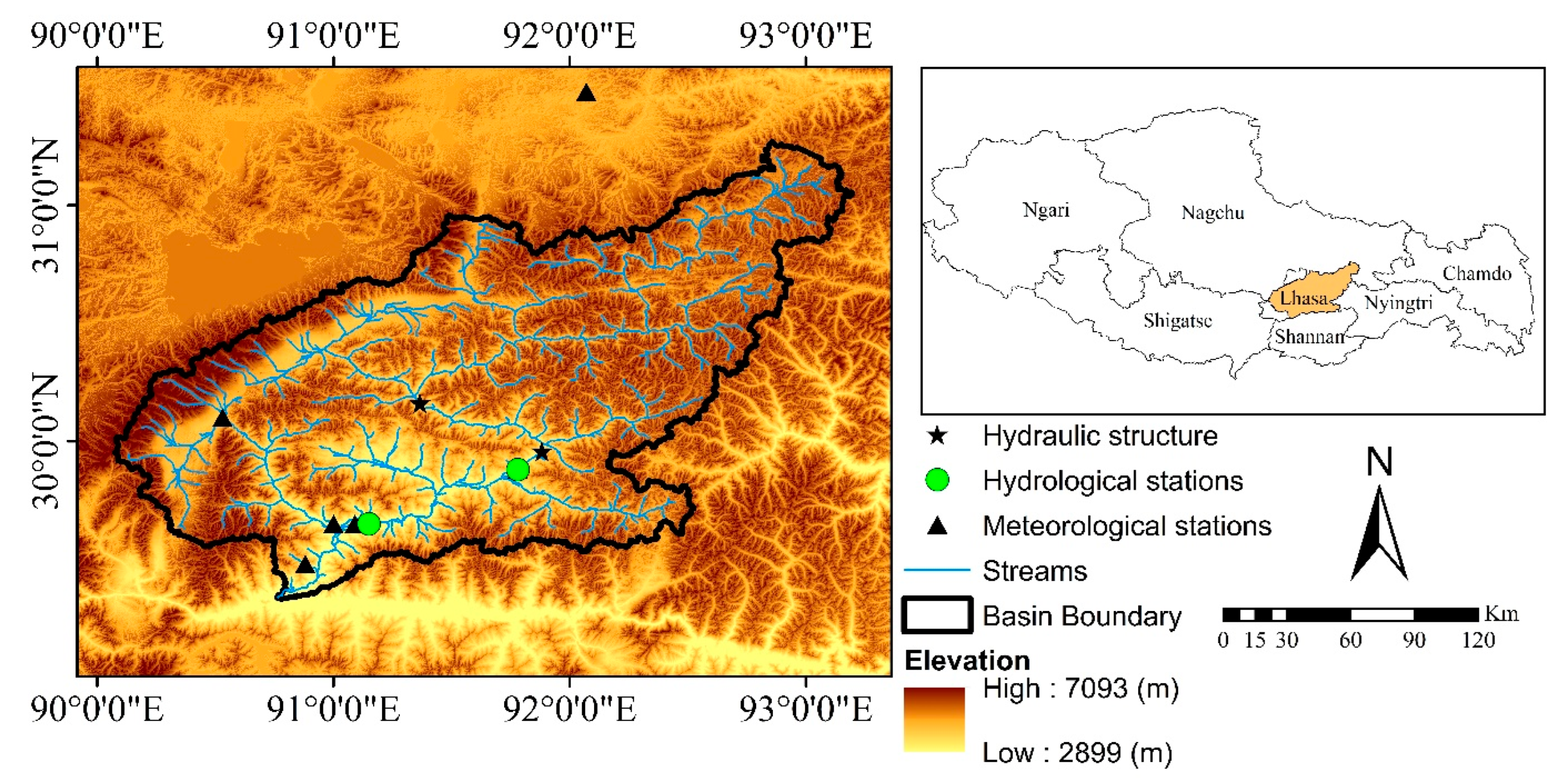



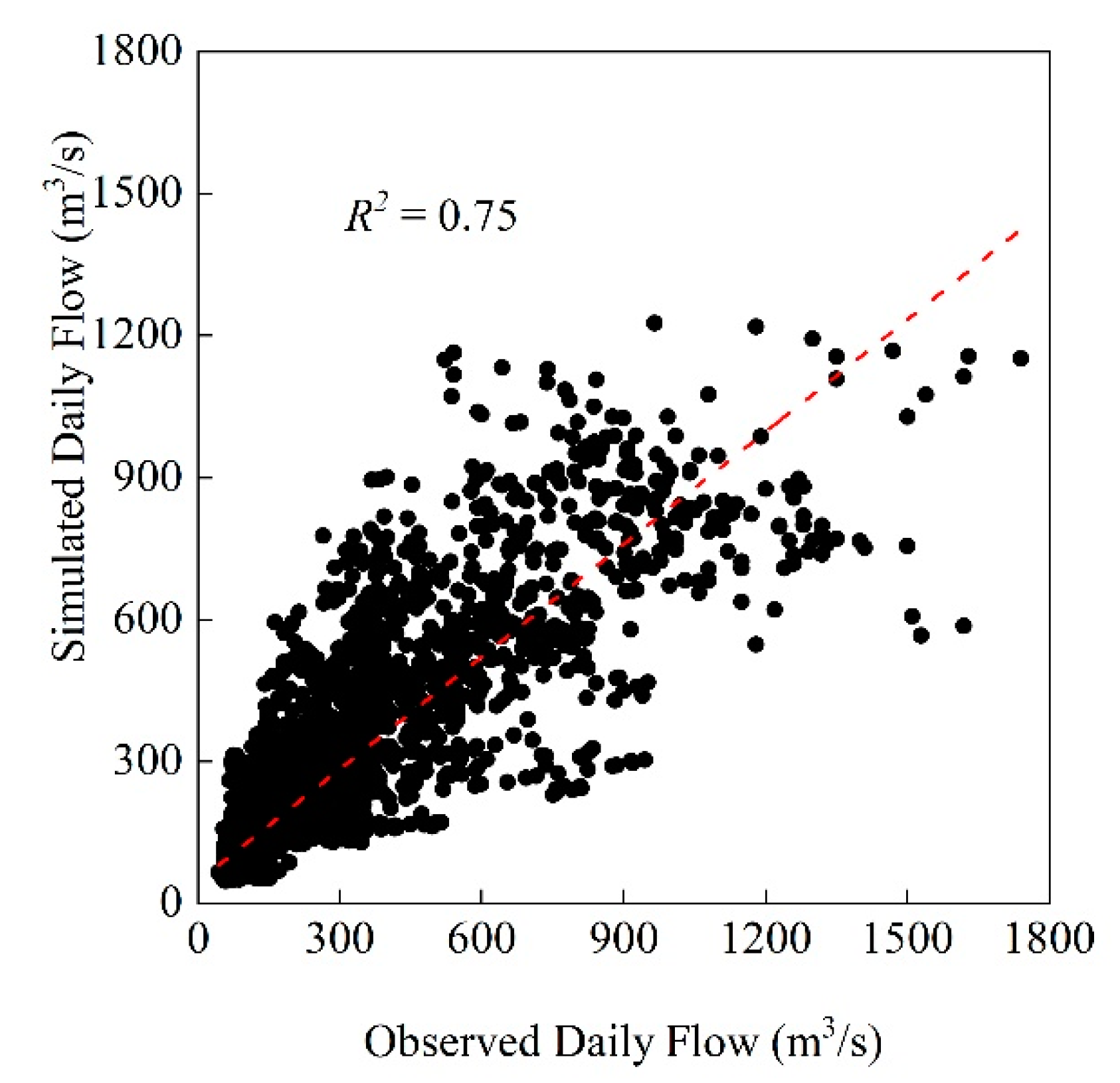
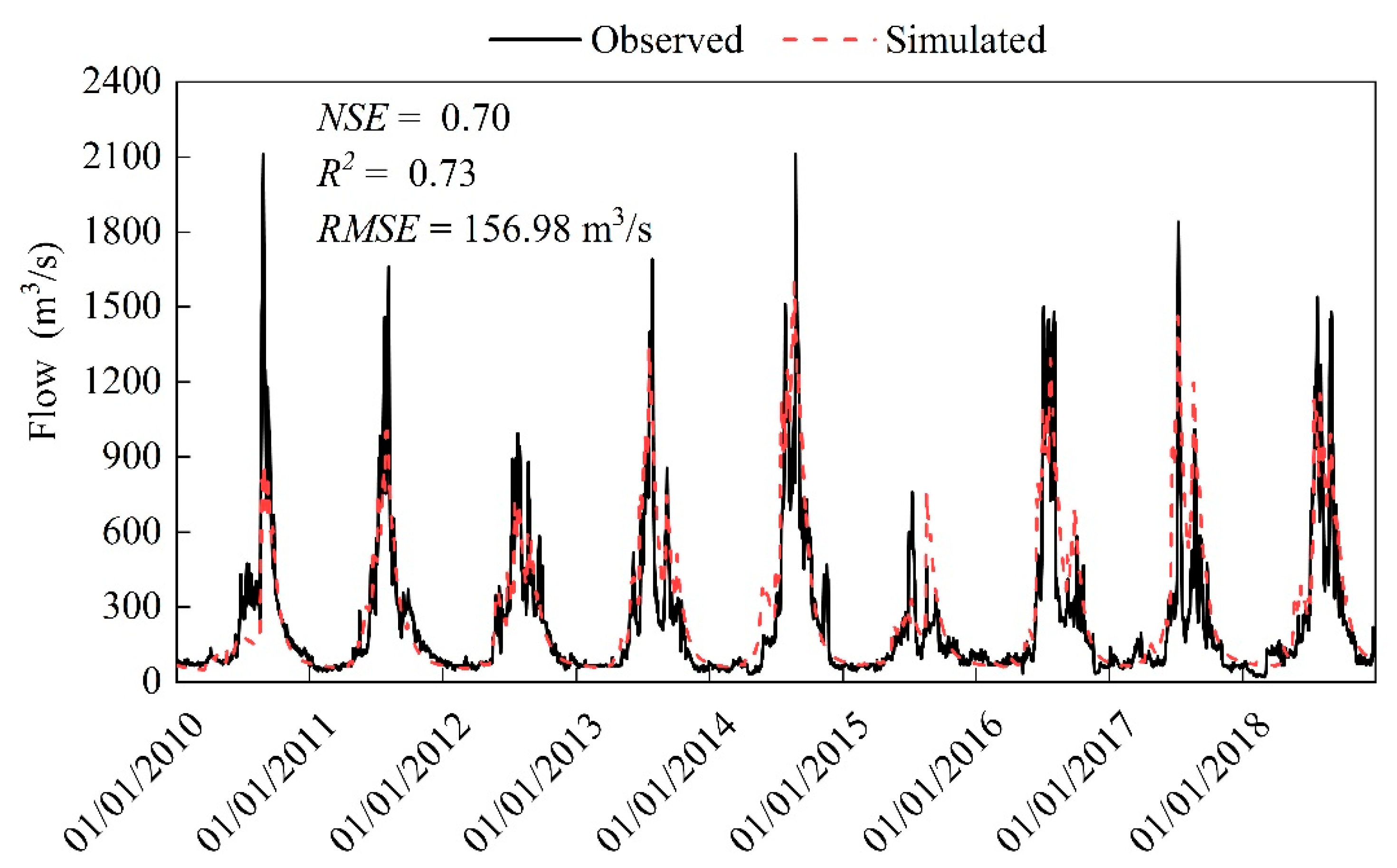
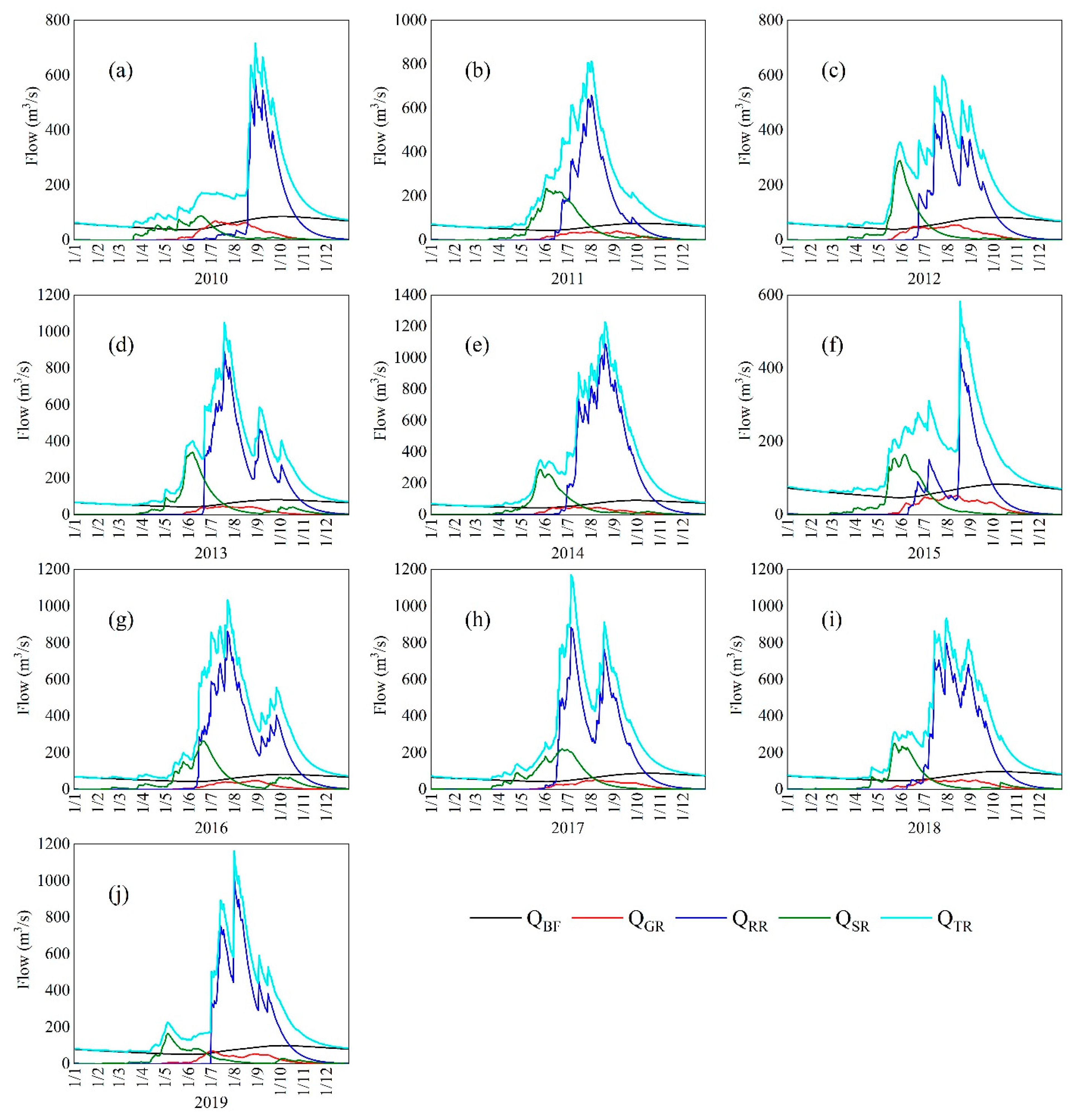
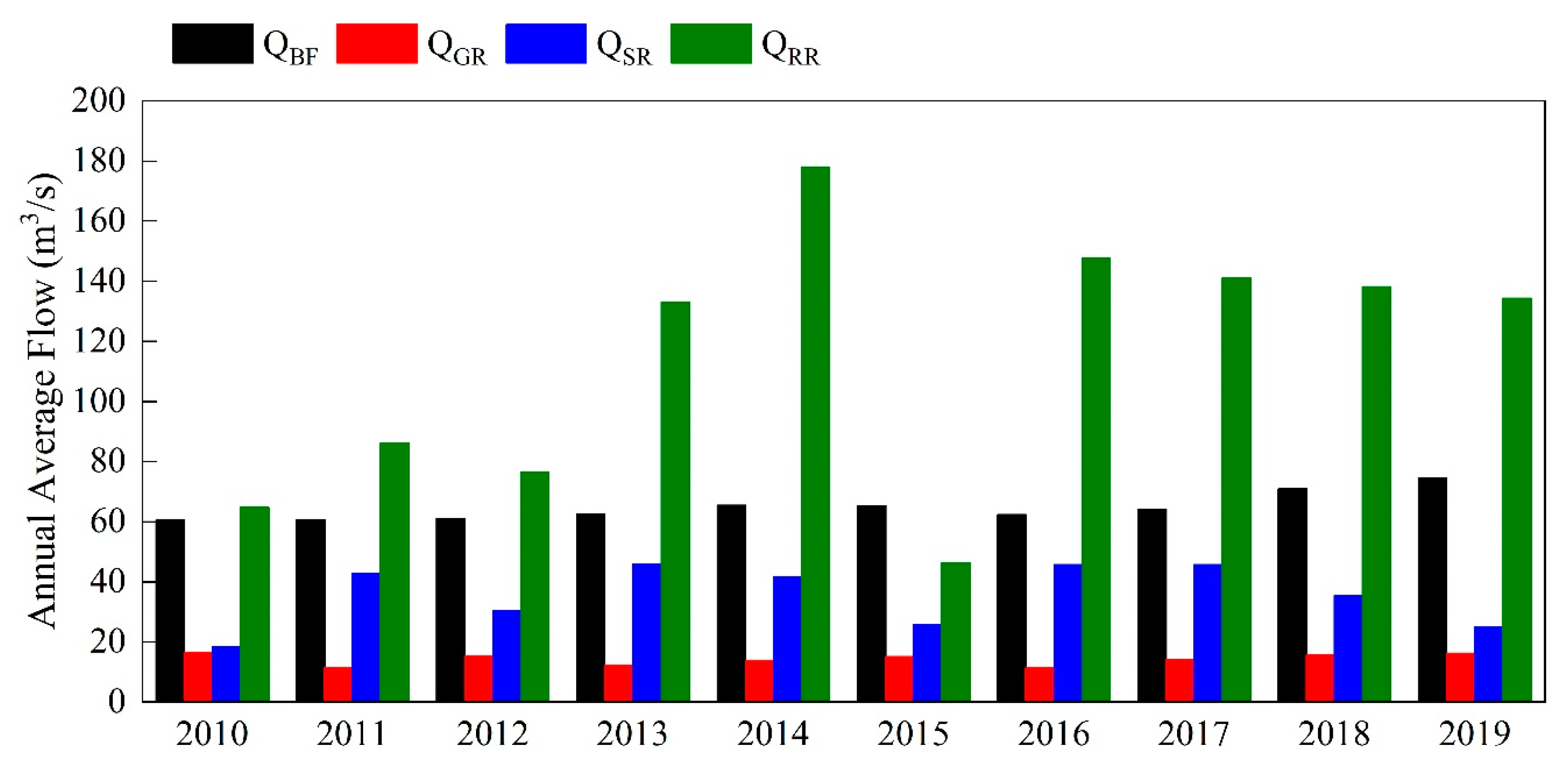

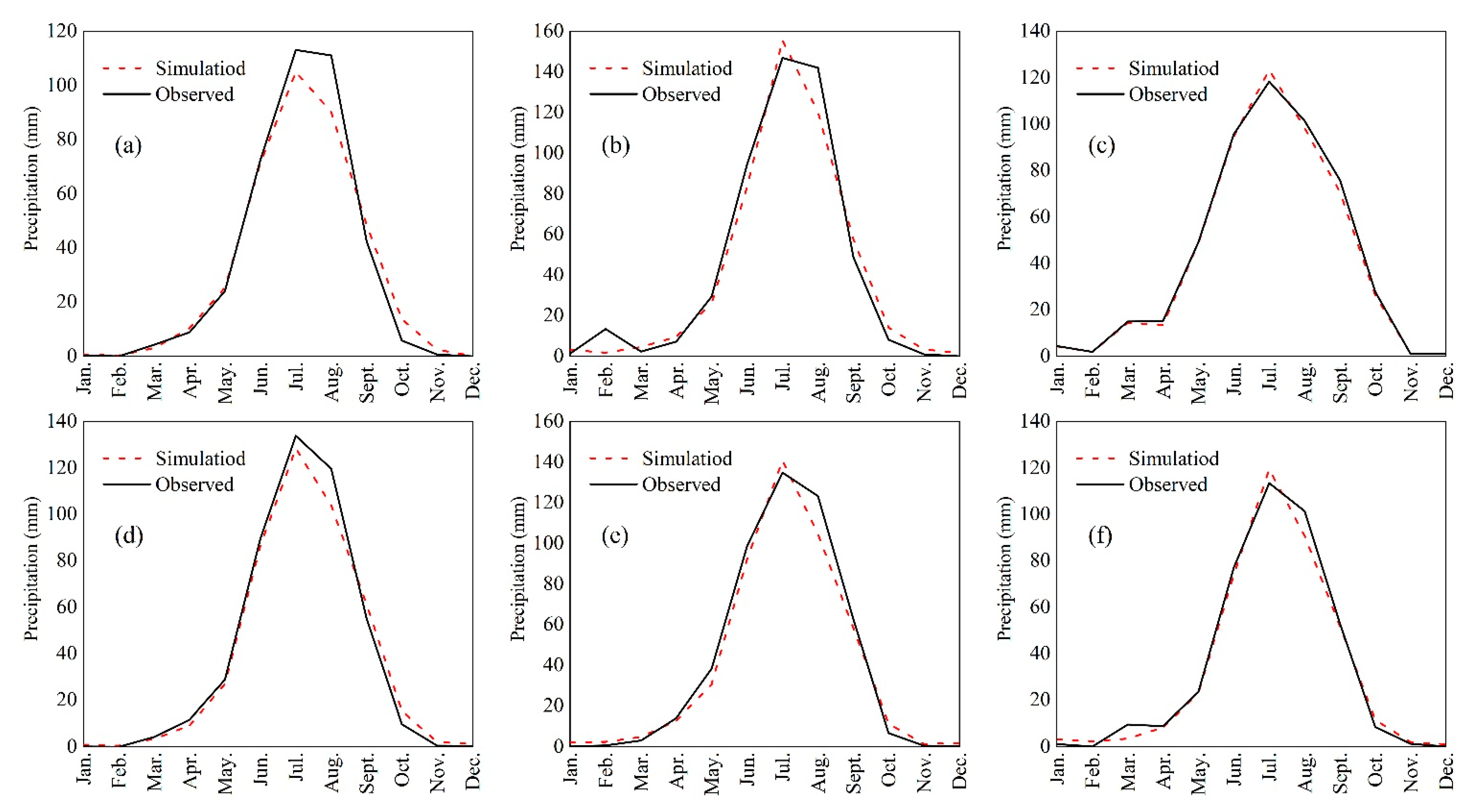
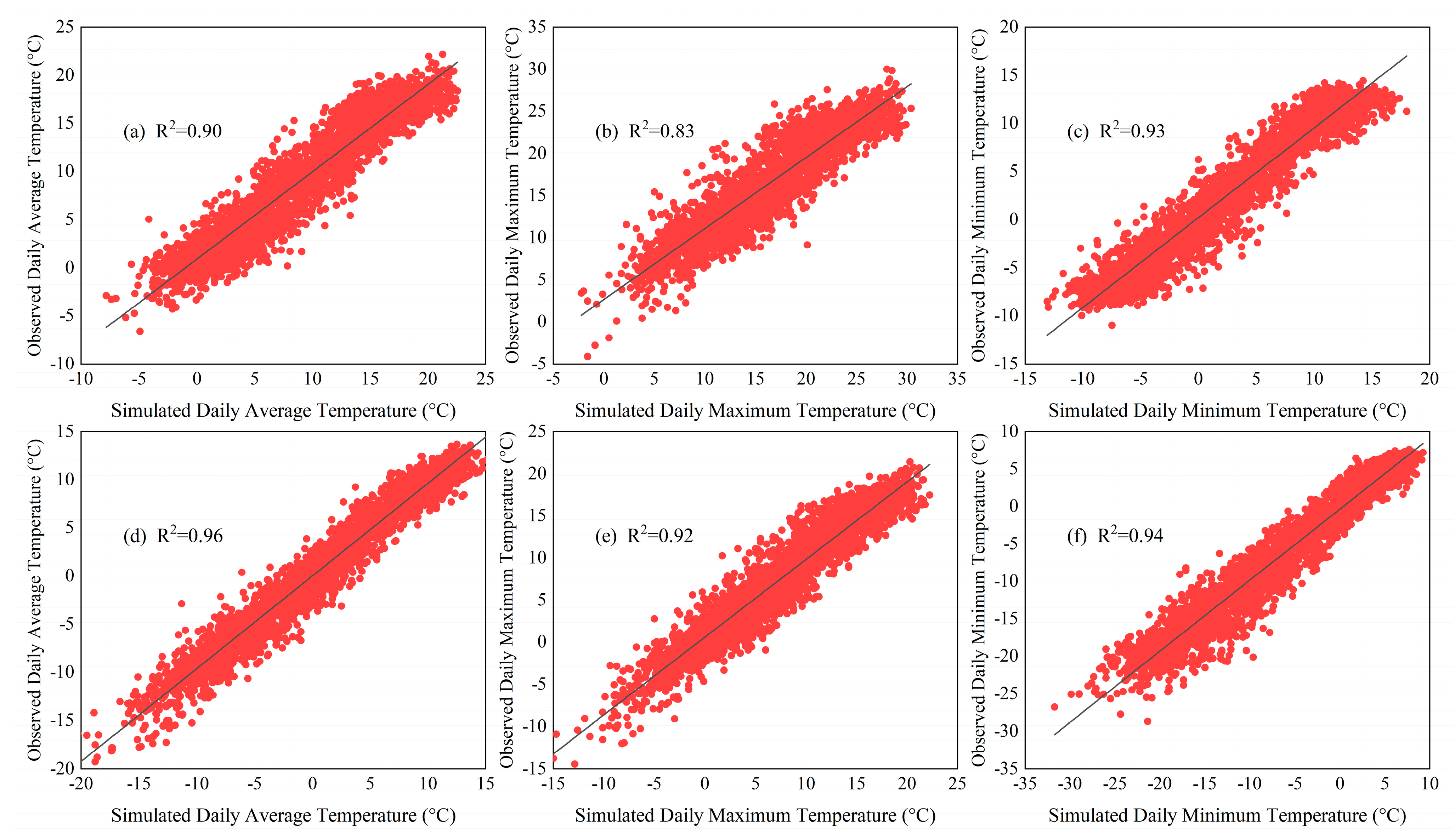

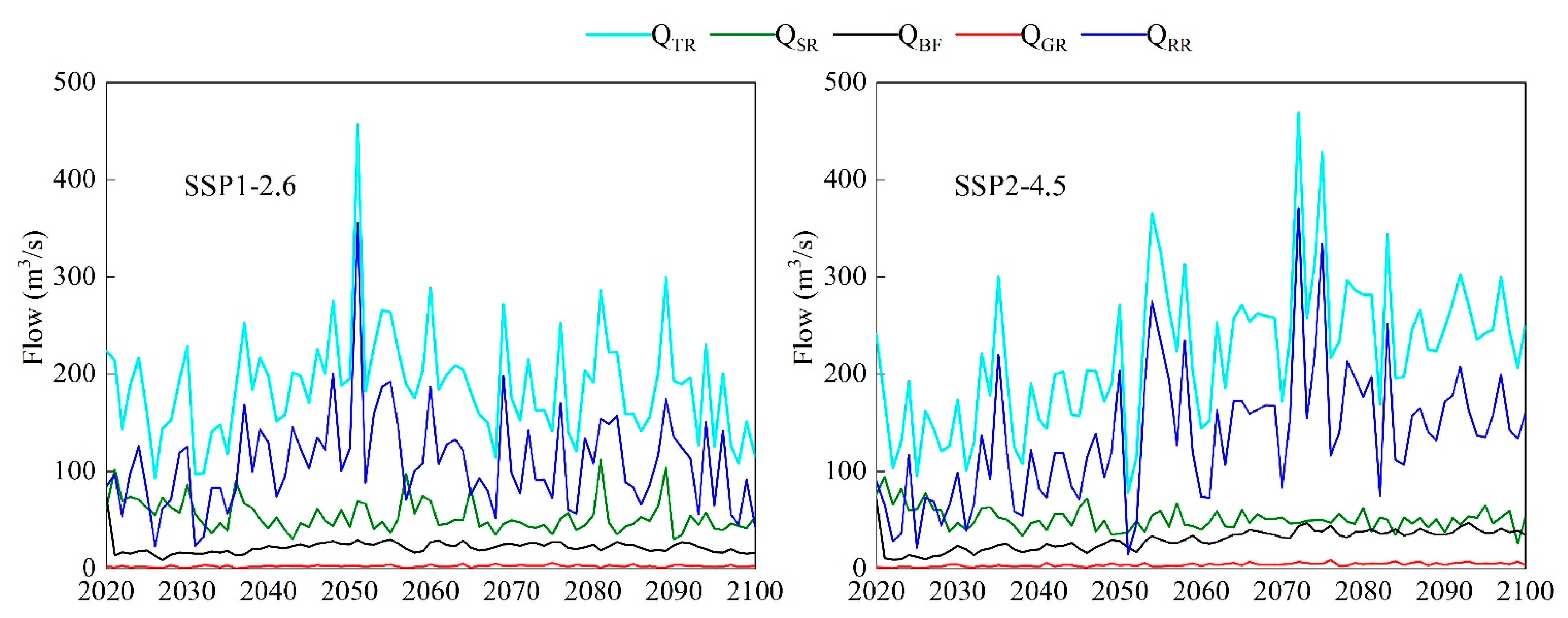
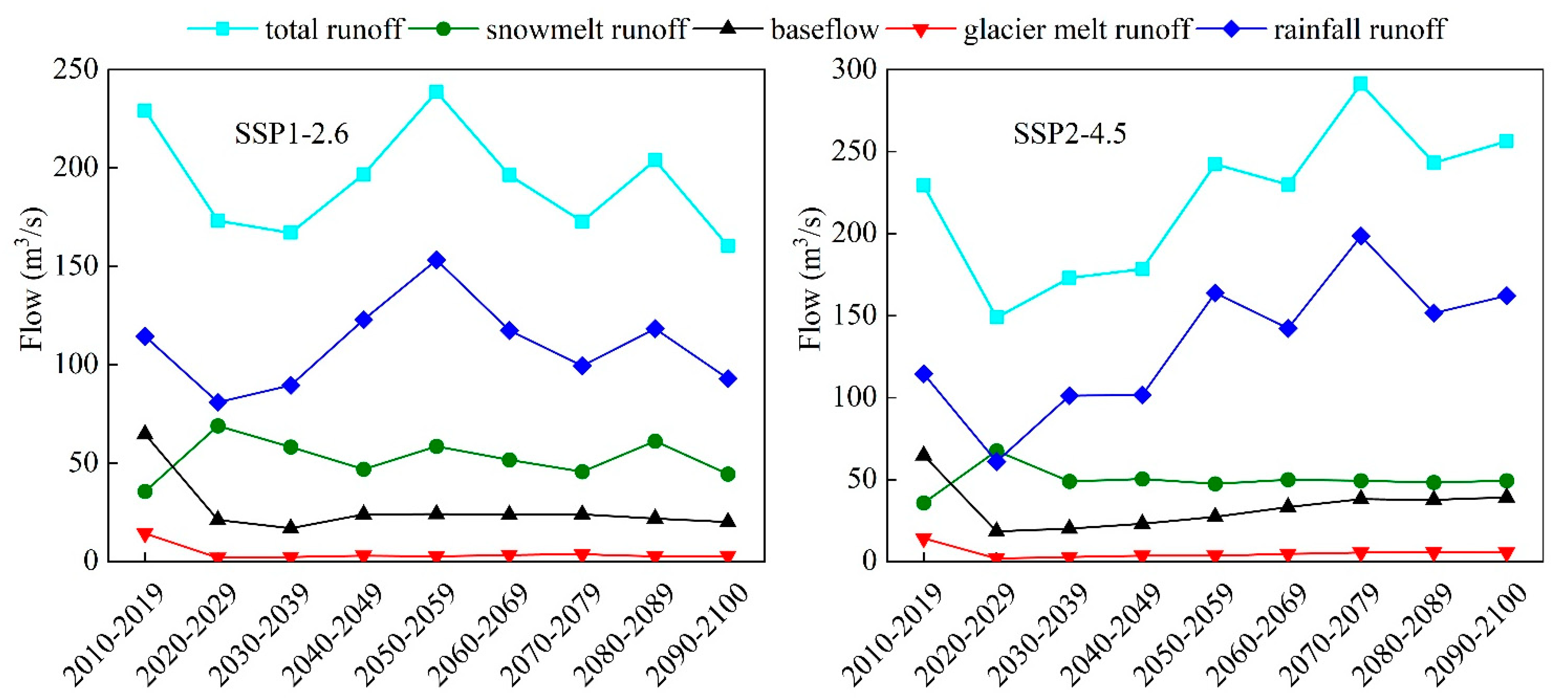
| Station Name | Lat/N | Lon/E | Elevation/m | Data Type | Period |
|---|---|---|---|---|---|
| DLDQ | 29°39′ | 91°00′ | 3657 | Precipitation | 2009–2019 |
| YBJ | 30°06′ | 90°32′ | 4315 | Precipitation | 2009–2019 |
| RRGB | 29°29′ | 90°53′ | 3798 | Precipitation | 2009–2019 |
| LHASA | 29°39′ | 91°09′ | 3650 | Precipitation/ Temperature/Runoff | 2009–2018 |
| TANGJIA | 29°53′ | 91°47′ | 4000 | Precipitation/runoff | 2009–2019 |
| PANGDUO | 30°09′ | 91°22′ | 4100 | Runoff | 2009–2019 |
| NAGQU | 31°29′ | 92°04′ | 4508 | Precipitation/Temperature | 2009–2019 |
| Step | Subsets of Hydrological Process | Objective Function | Parameters |
|---|---|---|---|
| 1 | GwDepth, GwSat, deltaGw, alphaGw | ||
| 2 | DDFS, Tcrit, SnowSC | ||
| 3 | DDFG, DDFDG, Glacf | ||
| 4 | RootDepthFlat, SubDepthFlat, CapRiseMax, kx |
| NO. | Name of the Parameter | Description (Unit) | Fitted Value |
|---|---|---|---|
| 1 | GwDepth | Groundwater layer thickness (mm) | 3000.00 |
| 2 | GwSat | Saturated groundwater content (mm) | 2000.00 |
| 3 | deltaGw | Delay time (d) | 0.01 |
| 4 | alphaGw | Baseflow recession coefficient (-) | 0.003 |
| 5 | DDFS | Snow degree-day factor (mm degree−1 day−1) | 0.85 |
| 6 | Tcrit | Temperature threshold for precipitation to rainfall as snow (°C) | 0.00 |
| 7 | SnowSC | Water storage capacity (mm mm−1) | 0.18 |
| 8 | DDFG | Glacier clean ice degree-day factor (mm degree−1 day−1) | 19.89 |
| 9 | DDFDG | Glacier debris degree-day factor (mm degree−1 day−1) | 20.00 |
| 10 | Glacf | Glacier melt runoff factor (-) | 0.22 |
| 11 | RootDepthFlat | Rootzone depth (mm) | 146.41 |
| 12 | SubDepthFlat | Sublayer thickness (mm) | 501.18 |
| 13 | CapRiseMax | The maximum amount of water from the subzone to the rootzone | 0.85 |
| 14 | kx | Recession coefficient of routing | 0.95 |
| Type of SSP | Increasing Rate of Annual Precipitation (mm/a) | Increasing Rate of Daily Average Temperature (°C/10a) | Increasing Rate of Daily Maximum Temperature (°C/10a) | Increasing Rate of Daily Minimum Temperature (°C/10a) |
|---|---|---|---|---|
| SSP1-2.6 | 0.76 | 0.08 | 0.13 | 0.06 |
| SSP2-4.5 | 3.57 | 0.25 | 0.19 | 0.24 |
| Total Runoff | Snowmelt Runoff | Baseflow | Glacier Melt Runoff | Rainfall-Runoff | |
|---|---|---|---|---|---|
| SSP1-2.6 | −0.31 | −0.02 | −0.27 | −0.07 | 0.04 |
| SSP2-4.5 | 1.13 | −0.01 | 0.01 | −0.03 | 1.16 |
Publisher’s Note: MDPI stays neutral with regard to jurisdictional claims in published maps and institutional affiliations. |
© 2022 by the authors. Licensee MDPI, Basel, Switzerland. This article is an open access article distributed under the terms and conditions of the Creative Commons Attribution (CC BY) license (https://creativecommons.org/licenses/by/4.0/).
Share and Cite
Xiang, X.; Ao, T.; Xiao, Q. Variation of Runoff and Runoff Components of the Lhasa River Basin in the Qinghai-Tibet Plateau under Climate Change. Atmosphere 2022, 13, 1848. https://doi.org/10.3390/atmos13111848
Xiang X, Ao T, Xiao Q. Variation of Runoff and Runoff Components of the Lhasa River Basin in the Qinghai-Tibet Plateau under Climate Change. Atmosphere. 2022; 13(11):1848. https://doi.org/10.3390/atmos13111848
Chicago/Turabian StyleXiang, Xin, Tianqi Ao, and Qintai Xiao. 2022. "Variation of Runoff and Runoff Components of the Lhasa River Basin in the Qinghai-Tibet Plateau under Climate Change" Atmosphere 13, no. 11: 1848. https://doi.org/10.3390/atmos13111848





